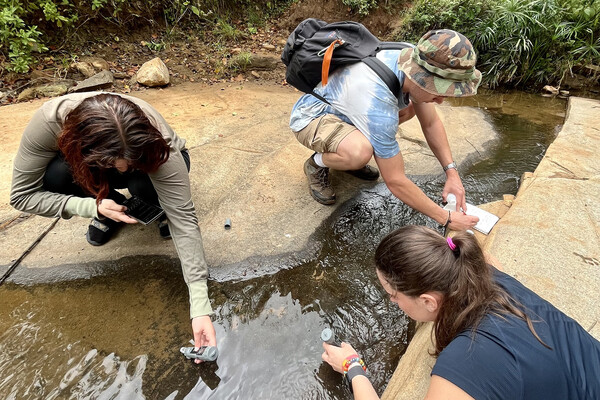
Griffin Pitt, right, works with two other student researchers to test the conductivity, total dissolved solids, salinity, and temperature of water below a sand dam in Kenya.
(Image: Courtesy of Griffin Pitt)
2 min. read
The more often someone is infected with COVID, the more likely they are to develop “long COVID,” according to a new pediatric study. Young people and children infected with the COVID virus for a second time are twice as likely to develop long COVID than their peers who have been infected just once. Long COVID from the second infection coincides with higher risks for heart disease, damaged kidneys, cognitive issues, and more, according to an analysis published in The Lancet Infectious Diseases from researchers at the Perelman School of Medicine.
“Many had hoped reinfections of COVID would be milder or carry less long-term risk, but we found increased risks for a broad range of conditions, challenging the assumptions many had that children bounce back quickly,” says first author Bingyu Zhang, an applied mathematics and computational science Ph.D. student in the Penn Computing, Inference and Learning (PennCIL) lab. “Our findings should inform clinical decision-making, support vaccine uptake, and guide how resources are allocated to monitor and care for COVID patients.”
Analysis of data from roughly 407,000 patients across 40 pediatric hospitals shows that among patients with just one documented COVID infection, there is a population-level rate of 904 cases of long COVID per million people every six months. The researchers found for those who experienced a second COVID infection, the rate more than doubles to 1,884 cases per million.
The researchers assessed the specific risk that a second infection posed for a variety of known conditions and symptoms that have been associated with long COVID by examining health records dating to the omicron wave. The records were studied for a documented diagnosis of long COVID, and then the researchers analyzed the records for updates covering a period of roughly one to six months after.
“Studying the public health consequences of COVID, including long COVID, helps us identify what children may be more vulnerable to after infection and direct support to them, such as allocating public health resources to monitor and manage long-term effects,” says co-author Jeffrey Morris, director of Biostatistics in the Department of Biostatistics, Epidemiology, and Informatics.
Read more at Penn Medicine News.
Frank Otto

Griffin Pitt, right, works with two other student researchers to test the conductivity, total dissolved solids, salinity, and temperature of water below a sand dam in Kenya.
(Image: Courtesy of Griffin Pitt)

Image: Andriy Onufriyenko via Getty Images

nocred

Provost John L. Jackson Jr.
nocred